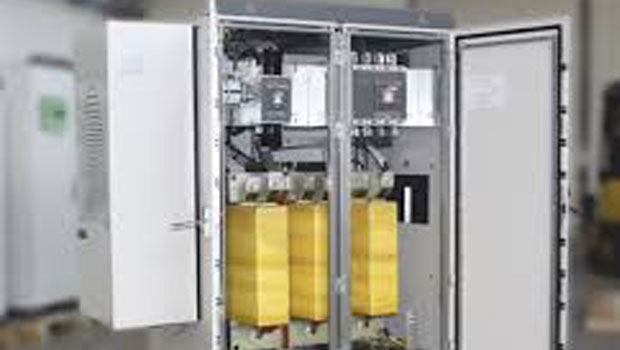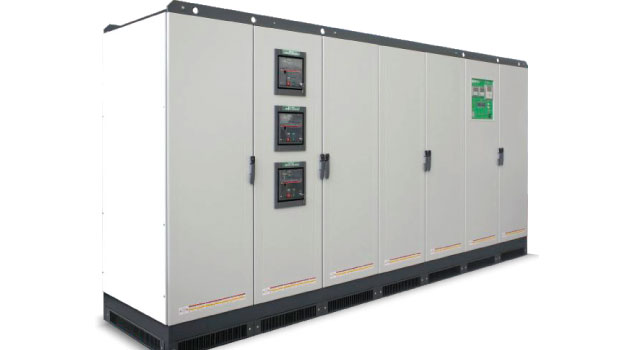Power and Control for Every Industry
AUTOMATIC VOLTAGE REGULATOR
An ORTEA AVR Automatic Voltage Regulator is a power device destined to be positioned between the mains and the User.
The purpose is to ensure that the User is fed a voltage subject to a variation much lower (±0.5% with regards to the nominal value) that the one guaranteed by the distributing system.
The stabilization is performed on the «true rms» voltage and it is not affected by harmonics in the mains.
Due to the fact that the regulation does not involve any sine wave slicing (which is what happens in power electronic converters such as inverters and UPSs),neither an appreciable harmonic distortion nor a phase displacement is introduced on the downstream line.
The AVR Automatic Voltage Regulator is not affected by the load power factor (cos φ) and can operate with a load percentage varying between 0% and 100% on each phase.
Regulation speed depends on the input voltage variation percentage and on the type of construction. Indicatively, said speed ranges between 8 and 30millisec/V.
Basically, An AVR Automatic Voltage Regulator is made of a buck/boost transformer, a voltage regulator and an electronic control. Based on a microprocessor that samples at high frequency the output voltage, the control system drives the regulator gearmotor.
By doing so, the regulator rollers change their position and therefore the voltage drawn and supplied to the buck/boost transformer primary winding.
Being the secondary voltage of the buck/boost transformer in phase or in opposition to the supply, the voltage drawn from the regulator is added or subtracted to the mains voltage, thus compensating its variations.
The AVR Automatic Voltage Regulator can operate with input and output voltage different (380V/415V) from the rated voltage (400V).
The ORTEA AVR Automatic Voltage Regulator are designed and built in compliance with the European Directives concerning CE marking 2006/95/EEC (Low Voltage Directive) and 2004/EEC (Electromagnetic Compatibility Directive). Standard units are housed in an IP21 metallic enclosure RAL7035 painted.
Cooling is guaranteed by natural air circulation aided by extracting fans over a certain temperature.
ORTEA’s catalogue includes a wide range of automatic voltage regulator:
Electrodynamic line conditioners
DISCOVERY – 50kVA to 4000kVA three-phase line conditioners
LYBRA – 0.3kVA to 150kVA single-phase line conditioners
ARIES – 2kVA to 450kVA three-phase line conditioners
Static voltage stabilizers
AQUARIUS – 3kVA to 30kVA three-phase voltage stabilizer
GEMINI – 0.5kVA to 10kVA single-phase voltage stabilizer
Electrodynamic voltage stabilizers
SIRIUS – 80kVA to 5000kVA three-phase voltage stabilizer
ANTARES – 7kVA to 150kVA single-phase voltage stabilises
ORION PLUS – 50kVA to 4000kVA three-phase voltage stabiliser
ORION – 2kVA to 450kVA three-phase voltage stabilizer
VEGA – 0.3kVA to 15kVA single-phase voltage stabilizer
DVS ELECTRO-MECHANICAL VOLTAGE STABILIZERS
A voltage stabilizer is a power device destined to be positioned between the mains and the User. The purpose is to ensure that the User is fed a voltage subject to a variation much lower (±0.5% with regards to the nominal value) that the one guaranteed by the distributing system.
The stabilization is performed on the «true rms» voltage and it is not affected by harmonics in the mains. Due to the fact that the regulation does not involve any intervention on the sinewave, neither an appreciable harmonic distortion nor a phase displacement is introduced on the downstream line.
The stabilizer is not affected by the load power factor (cos φ) and can operate with a load percentage varying between 0% and 100% on each phase. Regulation speed depends on the input voltage variation percentage and on the type of construction.
Indicatively, said speed ranges between 8 and 30millisec/V. Basically, a voltage stabilizer is made of a buck/boost transformer, a voltage regulator and an electronic control. Based on a microprocessor that samples at high frequency the output voltage, the control system drives the regulator gearmotor. By doing so, the regulator rollers change their position and therefore the voltage drawn and supplied to the buck/boost transformer primary winding. Being the secondary voltage of the buck/boost transformer in phase or in opposition to the supply, the voltage drawn from the regulator is added or subtracted to the mains voltage, thus compensating its variations. The voltage regulator is nothing but an autotransformer with continuously variable transformer ratio.
Depending on the stabilizer power, the regulator can be either toroidal or columnar.
The stabilizers are designed and built in compliance with the European Directives concerning CE marking (Low Voltage and Electromagnetic Compatibility Directives).
Standard units are housed in an IP21 metallic enclosure RAL7035 painted. Cooling is guaranteed by natural air circulation aided by extracting fans over a certain temperature.
The voltage stabilizer operating nominal voltage can be chosen from values (generally included in the range 380V / 415V). Such setting can be performed at the factory or at the Customer’s premises according to the instructions given in the reference technical handbook.
On Sirius and Sirius Advance stabilizers, the output voltage reference and the main configuration parameters can be set in different ways:
– through the local touch panel;
– directly by communicating with the microprocessor via a PC connection (through USB interfaces);
– from a remote station via Ethernet with MODBUS TCP/IP protocol.
Reactors
Thanks to a wide experience and a close co-operation with Customers, ORTEA has achieved a specific knowledge that allows for the construction of reactors suitable for all the different possibilities offered by the great variety of applications where these magnetic components are used. Being the production extremely versatile and flexible, ORTEA can provide with a wide range of solutions. Both for outdoor and indoor installation, ORTEA produces single-phase and three-phase reactors either with magnetic or air core, medium voltage insertion reactors, medium voltage choking inductors, tuning reactors, smoothing inductors, blocking reactors and current limiting reactors. Blocking, filtering and tuning reactors, together with capacitor banks, are used in power factor correction systems and harmonic filters. This type of reactor is usually provided with magnetic core thus allowing for high linearity even in presence of current peaks much higher than the rated current.
General purpose transformers
Very often, the purpose of a transformer is simply to adapt the incoming mains voltage to the level required by the plant or machinery supplied. If so, the transformer is customized to meet the user specifications. The professional competence of ORTEA’s technical department enables the processing of the data required in order to find the optimum solution in terms of performance, efficiency and economy.
Transformers for photovoltaic application
In actual fact, there transformers are isolating transformers designed in order to have very high efficiency, which means minimal losses. This characteristic is needed by the fact that photovoltaic conversion systems efficiency is intrinsically low. Using a low losses transformer contributes toward a better management of the system. The effect is to increase the energy quota that is transferred to the distributing company thus improving the overall economy of the plant.
Transformers for rectifiers
A rectifier converts AC voltage into DC voltage. In this application also, the transformer is specifically developed for the rectifying unit to which it is destined. The conversion group can have different configurations (three-phase bridge, six-phase with or without interphasic reactor, twelve-phase, and so on) and each of them requires the design of a dedicated transformer. Rectifiers are generally used for special industrial applications, mainly destined to galvanic plants (chrome-plating, zinc-plating, etc.). This kind of use requires extremely high currents (very often, thousands of Amps are necessary). ORTEA’s technical department skills and competence allow for studying the best solution for the critical issue given by the output bar configuration.
UPS transformers
These transformers are used in the AC/DC conversion and DC/AC rectifying groups typical of UPS systems. The transformers are usually extremely tailored to the UPS. Standard models cannot be defined, as each transformer design is strictly linked to the UPS into which the transformer needs to be assembled. Both the electrical properties and the mechanical characteristics satisfy precise specifications drawn up by the ups manufacturer. A close co-operation is therefore an essential requisite for developing the best solution. Thanks to the expertise achieved through decades of experience in this sector, ORTEA is able to design and manufacture UPS transformers of any kind. The partnership with major UPS producers worldwide is evidence of the high reliability achieved.
K Transformers for non-linear load
The K-rated transformers are isolation transformers specifically designed to withstand the phenomena due to the fact that non-linear loads generate high levels of harmonic distortion. Typical non-linear load are computers, variable speed drives, inverters, welders and so on. Harmonic generation results in increased current absorption and therefore higher losses. In order to ensure that the thermal class temperature limit is respected, the transformer design must keep into consideration the presence of said harmonics. The K factor is an indication of how much the harmonic distortion affects the system: the higher is K, the higher is the harmonic content that the transformer must withstand without any damage. It is worth reminding that a K-rated transformers does not cancel the harmonics in the system (except for third and triplen harmonics), but is able to tolerate their effects. In order to reduce or eliminate the harmonic content, it is necessary to arrange suitable filtering equipment.
Isolation transformers
Isolation transformers are specifically designed and manufactured to ensure load protection by means of galvanic separation between the mains and the user. Typical fields of application are telecommunication systems, data centre supply systems, ‘trafoless’ UPSs supply, bypass lines protection, public buildings and hospitals. An isolation transformer is always fitted with an electrostatic shield between primary and secondary windings for noise attenuation and discharge to ground of voltage surge. Windings are built in delta/star or delta/zigzag configuration (with available neutral point) in order to cancel the third and triplen harmonics.
Standard Power Factor Correction
The standard power factor correction is used in those plants where there are no current heavily deformed (verify the THD% data of the system current, which must be less than THDIR% of the selected power factor correction family) or resonance problems.
If the harmonics presence in the plant is not negligible, are preferred solutions with reinforced capacitors (i.e. with an higher nominal voltage than that of the network). In case of use in systems with heavy duty cycle, or in the case of installation in cabinets with high temperature, solutions with vacuum impregnated capacitors or bimetallized paper capacitors are preferred.


